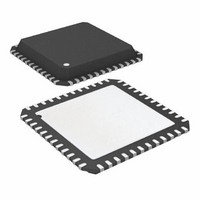AD9511BCPZ Analog Devices Inc, AD9511BCPZ Datasheet - Page 29

AD9511BCPZ
Manufacturer Part Number
AD9511BCPZ
Description
IC CLOCK DIST 5OUT PLL 48LFCSP
Manufacturer
Analog Devices Inc
Type
Fanout Buffer (Distribution), Divider, PLLr
Datasheet
1.AD9511BCPZ.pdf
(60 pages)
Specifications of AD9511BCPZ
Number Of Circuits
1
Ratio - Input:output
2:5
Differential - Input:output
Yes/Yes
Input
Clock
Output
CMOS, LVDS, LVPECL
Frequency - Max
1.2GHz
Voltage - Supply
3.135 V ~ 3.465 V
Operating Temperature
-40°C ~ 85°C
Mounting Type
Surface Mount
Package / Case
48-LFCSP
Frequency-max
1.2GHz
Clock Ic Type
Clock Distribution
Ic Interface Type
Serial
Frequency
1.2GHz
No. Of Outputs
5
No. Of Multipliers / Dividers
5
Supply Voltage Range
3.135V To 3.465V
Lead Free Status / RoHS Status
Lead free / RoHS Compliant
For Use With
AD9511/PCB - BOARD EVAL CLOCK DISTR 48LFCSPAD9511-VCO/PCB - BOARD EVAL CLOCK DISTR 48LFCSP
Lead Free Status / RoHS Status
Lead free / RoHS Compliant, Lead free / RoHS Compliant
Available stocks
Company
Part Number
Manufacturer
Quantity
Price
Company:
Part Number:
AD9511BCPZ
Manufacturer:
ADI
Quantity:
139
Part Number:
AD9511BCPZ
Manufacturer:
ADI/亚德诺
Quantity:
20 000
Part Number:
AD9511BCPZ-REEL7
Manufacturer:
ADI/亚德诺
Quantity:
20 000
FUNCTIONAL DESCRIPTION
OVERALL
Figure 33 shows a block diagram of the AD9511. The chip
combines a programmable PLL core with a configurable clock
distribution system. A complete PLL requires the addition of a
suitable external VCO (or VCXO) and loop filter. This PLL can
lock to a reference input signal and produce an output that is
related to the input frequency by the ratio defined by the
programmable R and N dividers. The PLL cleans up some jitter
from the external reference signal, depending on the loop
bandwidth and the phase noise performance of the VCO
(VCXO).
The output from the VCO (VCXO) can be applied to the clock
distribution section of the chip, where it can be divided by any
integer value from 1 to 32. The duty cycle and relative phase of
the outputs can be selected. There are three LVPECL outputs
(OUT0, OUT1, and OUT2) and two outputs that can be either
LVDS or CMOS level outputs (OUT3 or OUT4). OUT4 can
also make use of a variable delay block.
Alternatively, the clock distribution section can be driven
directly by an external clock signal, and the PLL can be powered
off. Whenever the clock distribution section is used alone, there
is no clock clean-up. The jitter of the input clock signal is
passed along directly to the distribution section and may
dominate at the clock outputs.
PLL SECTION
The AD9511 consists of a PLL section and a distribution
section. If desired, the PLL section can be used separately from
the distribution section.
The AD9511 has a complete PLL core on-chip, requiring only
an external loop filter and VCO/VCXO. This PLL is based on
the ADF4106, a PLL noted for its superb low phase noise
performance. The operation of the AD9511 PLL is nearly
identical to that of the ADF4106, offering an advantage to those
with experience with the ADF series of PLLs. Differences
include the addition of differential inputs at REFIN and CLK2,
and a different control register architecture. Also, the prescaler
has been changed to allow N as low as 1. The AD9511 PLL
implements the digital lock detect feature somewhat differently
than the ADF4106 does, offering improved functionality at
higher PFD rates. See the Register Map Description section.
PLL Reference Input—REFIN
The REFIN/REFINB pins can be driven by either a differential
or a single-ended signal. These pins are internally self-biased so
that they can be ac-coupled via capacitors. It is possible to dc-
couple to these inputs. If REFIN is driven single-ended, the
unused side (REFINB) should be decoupled via a suitable
Rev. A | Page 29 of 60
capacitor to a quiet ground. Figure 34 shows the equivalent
circuit of REFIN.
VCO/VCXO Clock Input—CLK2
The CLK2 differential input is used to connect an external VCO
or VCXO to the PLL. Only the CLK2 input port has a
connection to the PLL N divider. This input can receive up to
1.6 GHz. These inputs are internally self-biased and must be ac-
coupled via capacitors.
Alternatively, CLK2 may be used as an input to the distribution
section. This is accomplished by setting Register 45h<0> = 0b.
The default condition is for CLK1 to feed the distribution section.
PLL Reference Divider—R
The REFIN/REFINB inputs are routed to reference divider, R,
which is a 14-bit counter. R may be programmed to any value
from 1 to 16383 (a value of 0 results in a divide by 1) via its
control register (OBh<5:0>, OCh<7:0>). The output of the R
divider goes to one of the phase/frequency detector inputs. The
maximum allowable frequency into the phase, frequency
detector (PFD) must not be exceeded. This means that the
REFIN frequency divided by R must be less than the maximum
allowable PFD frequency. See Figure 34.
VCO/VCXO Feedback Divider—N (P, A, B)
The N divider is a combination of a prescaler, P, (3 bits) and two
counters, A (6 bits) and B (13 bits). Although the AD9511’s PLL
is similar to the ADF4106, the AD9511 has a redesigned
prescaler that allows lower values of N. The prescaler has both a
dual modulus (DM) and a fixed divide (FD) mode. The
AD9511 prescaler modes are shown in Table 14.
REFINB
REFIN
CLKB
V
CLK
Figure 35. CLK1, CLK2 Equivalent Input Circuit
S
V
10kΩ
10kΩ
S
Figure 34. REFIN Equivalent Circuit
2.5kΩ
5kΩ
5kΩ
12kΩ
10kΩ
2.5kΩ
150Ω
150Ω
CLOCK INPUT
STAGE
AD9511














